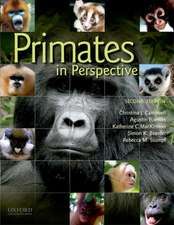Strategies of Sex and Survival in Female Hamadryas Baboons: Through a Female Lens: Primate Field Studies
Autor Larissa Swedellen Limba Engleză Paperback – 25 feb 2005
Preț: 366.85 lei
Nou
Puncte Express: 550
Preț estimativ în valută:
70.19€ • 73.29$ • 58.10£
70.19€ • 73.29$ • 58.10£
Carte tipărită la comandă
Livrare economică 04-18 aprilie
Preluare comenzi: 021 569.72.76
Specificații
ISBN-13: 9780131845480
ISBN-10: 0131845489
Pagini: 274
Dimensiuni: 152 x 229 x 18 mm
Greutate: 0.39 kg
Ediția:New.
Editura: Taylor & Francis
Colecția Routledge
Seria Primate Field Studies
Locul publicării:Oxford, United Kingdom
ISBN-10: 0131845489
Pagini: 274
Dimensiuni: 152 x 229 x 18 mm
Greutate: 0.39 kg
Ediția:New.
Editura: Taylor & Francis
Colecția Routledge
Seria Primate Field Studies
Locul publicării:Oxford, United Kingdom
Public țintă
UndergraduateNotă biografică
Larissa Swedell is Professor of Anthropology at Queens College, CUNY, USA. As a biological anthropologist, her interest in nonhuman primates derives in part from what their behavior, ecology, and evolution can tell us about the evolutionary history of humans and the biological underpinnings of modern human behavior. As a behavioral ecologist, she is most interested in the interacting reproductive strategies of males and females and the evolutionary advantages of sociality and social bonds.
Cuprins
1. Hamadryas Baboons: the Male as Leader and Icon.2. Reproductive Strategies in Primates: Conflicts Between the Sexes.3. My Study Site, Subjects, and Methods.4. Hamadryas Behavioral Ecology: Negotiating a Hostile Land.5. Hamadryas Social Organization: the Haves and the Have-Nots.6. Reproduction and the Hamadryas Female.7. Affiliation Among Females: Females Can Be Friends Too.8. Dispersal and Philopatry: Who Stays and Who Goes?9. Female Strategies in a Male-Dominated World.Bibliography.Index
Descriere
This book describes the first field study focusing on the behavior of hamadryas females in the wild. In its attempt to rectify the male-biased view of hamadryas baboon behavior that has persisted over the decades, this book suggests that female behavior contributes more to hamadryas social organization than has previously been assumed and that females may, in fact, be acting in their own best interests after all. For upper-level undergraduate courses on primate behavior and ecology.
















